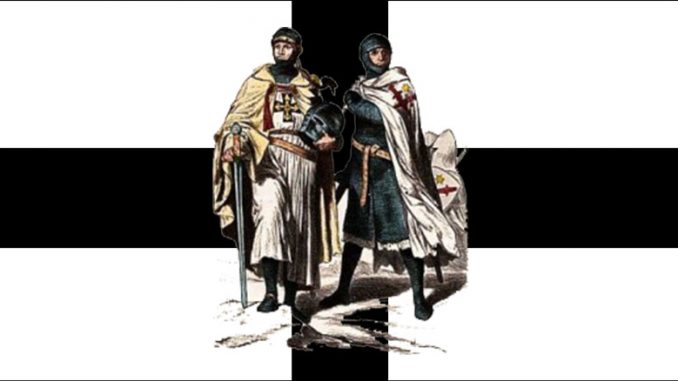
The Teutonic Knights of St. Mary’s Hospital of Jerusalem was one of the three great religious and military orders produced by the Crusades. It was founded during the third Crusade, and was the last one formed. Its hospital was founded by Germans.
Very early in the history of the Order its members were all ennobled, and they have remained so ever since. It was never a universal Order, like the Templars and the Hospitallers. It was strictly national in character. Like the other two Orders it began as a charitable society, passed into a military one and finally reached sovereign power.
In 1291 it was expelled by the Moslems from the Holy Land. In 1309 it established itself in what is now Marienburg, West Prussia. It had begun its work, however in Eastern Germany a hundred years before for the purpose of subduing and converting the heathens. The Knightly Order of Dobrzin, founded for the purpose of conquering the heathen Prussians, was merged in the Teutonic Knight 1235, just as an older organized for the same pose, was merged in it years before.
The Order finally became a governing aristocracy, holding its lands in Eastern Germany as a fief of the Pope of Rome. The Grand Master became in reality a king with the Pope as Emperor. However, the monarch, if such it may be called, a limited one as a council of brethren had to be consulted in all affairs. The state was really the church, and the government was ecclesiastical in character. The country was governed somewhat as the States of the Church in Italy were governed before 1871, when the temporal power of the Pope was abolished. The greater part of their subjects were the conquered Prussian heathens from whom the present peasants are descended. They were serfs bound to the soil. 0f course their souls were now safe, but the only earthly right, if right it could be called, that they obtained through their conversion, was the right to work for the Knights, their masters, and fight for them in time of war.
The Order reached its height in the latter part of the 14th century. Its very rights weighted it down. Its neighbors envied its wealth, and wanted its territories. The Hundred Years War weakened it. Poland finally got West Prussia, and while East Prussia was left to the Knights, Poland became its overlord. Lutherism gave it its final blow. When the Hohenzollern Albert, Grand Master of the Order, turned Protestant, he secularized its territories into a Duchy under Poland. Later on all of the country East of Germany was secularized and the Order confined wholly to Germany. The German Grand Master became a Prince of the Empire.
The Order still continued on in its conservatism, always claiming its old rights. It maintained itself from its still large revenues from its estates in different parts of Germany. During the French Revolution, however, it was deprived of all of its estates, which went to the different principalities in which they were situated. It was suppressed in 1809, but in 1840 it was revived in Austria under the patronage of the Emperor of Austria, and so continued down to the ending of the Great War.
Grand Masters of the Teutonic Knights
The following list is a partial list and is only concerned with those Grand Masters of the Order during the original Templar era.
1198-1200 – Heinrich I Walpot von Bassenheim
1200-1206 – Otto von Kerpen
1206-1209 – Heinrich II von Tunna
1209-1239 – Hermann von Salza
1239-1240 – Konrad I of Thuringia
1241-1244 – Gerhard von Malberg
1244-1249 – Heinrich III von Hohenlohe
1249-1253 – Gonther von Schwarzenburg
1253-1257 – Poppo von Osterna
1257-1274 – Hanno von Sangershausen
1274-1283 – Hartmann von Helbrungen
1283-1290 – Burkhard von Schwanden
1290-1297 – Konrad II von Feuchtwangen
1297-1302 – Gottfried von Hohenlohe
1302-1310 – Siegfried von Feuchtwangen
1311-1324 – Karl Bessart
About Us
We hope you enjoyed this article on the Teutonic Knights.
TemplarHistory.com was started in the fall of 1997 by Stephen Dafoe, a Canadian author who has written several books on the Templars and related subjects.
Read more from our The Crusades Archives – Templar History
